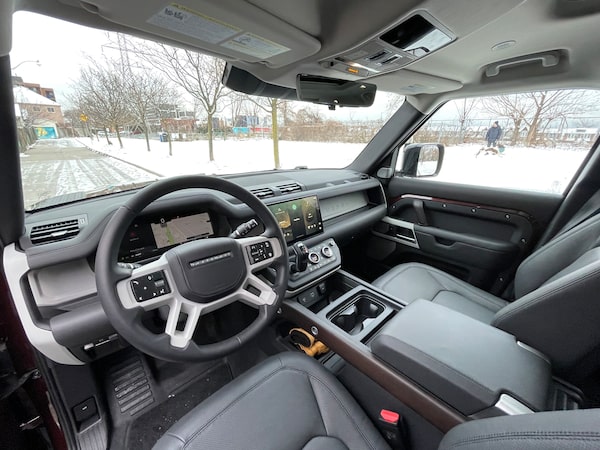
2023 Land Rover Defender 130 is 1.97 metres high, which makes parking in some garages a challenge.Matt Bubbers/The Globe and Mail
Land Rover’s adventurous Defender SUV is built to go just about anywhere: up mountains, wading through rivers, across frozen tundra. The new $93,000 Defender 130 is an elongated eight-seat version of the popular Defender 110. If the need ever arose, the 130 could carry the Toronto Maple Leafs’ entire starting lineup and their coach across ridiculously rugged landscapes.
“It allows customers to effortlessly transport up to eight people across any terrain and is the ultimate demonstration of Defender’s breadth of talents,” proclaims the company.
And yet, faced with an ordinary underground parking garage, the Defender finds itself at an impasse. It’s too tall to enter, forced to retreat, defeated by a simple plastic tube dangling by chains from a garage roof. There’s no arguing with the tube; the SUV’s roof rails touch it, and so the giant Defender must reverse awkwardly back up the ramp, causing minor traffic chaos.
We venture into yet another parking garage only to be turned away again by another dangling tube. When we do eventually find a suitable parking venue, the Land Rover is so long, its nose sticks out of its parking spot.
All tall SUVs and pickups suffer from an inability to infiltrate certain underground garages and tight parking spaces, but it seems like more of a problem on an SUV promising go-anywhere, do-anything ability.
At 1.97 metres tall – about the height of Dwayne (The Rock) Johnson – (or 1.79 with the suspension lowered) – the largest Land Rover SUV is taller than a Cadillac Escalade, the same height as a Mercedes-AMG G63, but slightly shorter than the Bronco Raptor or Dodge Ram TRX. The Defender’s height gives it real off-road chops: up to 290 millimetres of ground clearance, the ability to navigate knee-deep water and approach slopes of 37.5 degrees without scraping the front bumper.
Realistically, the 130′s main selling point, however, is its extra length. At 5.36 metres long, including the spare wheel fixed to the trunk, it’s 340 millimetres longer than the Defender 110. The additional square-footage allows for a cavernous cargo hold and seating for up to eight, where the shorter 110 offers up to seven chairs and a child-only third row.

From the driver’s seat, driving the extended Defender feels like being at the wheel of an armoured personnel carrier.Matt Bubbers/The Globe and Mail
Climbing into the third row of the 130 is a bit of an ordeal, requiring a lunge upward, then a tight crouch under the roof and a spin-plop into the seat. It’s not elegant, but at least there is actually room for adults back there.
From the driver’s seat, the extended Defender feels like an armoured personnel carrier. Outward visibility is poor with large blind spots all around simply because the vehicle is so gigantic. (All large trucks and SUVs suffer from this problem; they’re also more deadly to pedestrians and cyclists in the event of a collision.)
The Defender’s rear-view mirror is hopeless; the spare tire blocks what little view there is. Thankfully, the mirror doubles as a screen, showing a (somewhat limited) view from a rear-mounted camera. An array of radar sensors and cameras around the vehicle make parking easy, though, assuming you can find a large enough spot.
If this big and brutish Land Rover is near the top of your short list, you have to ask yourself: Is the oversized Defender 130 worth the inconvenience that comes with driving such a tank?
When it comes to transporting people, a minivan is still the best (albeit frumpiest) solution, and you’ll never have to worry about parking-garage height restrictions. When it comes to climbing mountains and fording rivers, a smaller off-roader like the two-door Defender 90 or Jeep Wrangler are more capable. Or, if you simply want to feel rough and rugged while driving around your suburban cul-de-sac, the mid-size Defender 110 is more manageable. However, on the off chance you are an Iceland tour operator or a family of eight living in the deepest wilderness, then the Defender 130 has no equal.

2023 Land Rover Defender 130.Matt Bubbers/The Globe and Mail
Tech specs
2023 Land Rover Defender 130
- Base price/as tested: $93,000/$107,380 (P400 First Edition)
- Engine: Three-litre inline-six mild hybrid (P400)
- Transmission/drive: Eight-speed automatic/all-wheel drive
- Fuel economy (litres per 100 kilometres): 13.8 city, 11.2 highway
- Alternatives: Mercedes-Benz GLS, Cadillac Escalade, Jeep Grand Wagoneer, Land Rover Defender 110, BMW X7, Lexus LX, a minivan and a good set of winter tires
Looks
It’s like the designers just went into Photoshop and stretched the trunk.
Interior

2023 Land Rover Defender 130 has a large menu of colour and trim options.Matt Bubbers/The Globe and Mail
It’s still one of the best-designed dashboards in the business – highly original and functional, with a large menu of colour and trim options.
Performance
In the P400 trim, this 2,500-kilogram behemoth is surprisingly (needlessly) quick off the line with 395 horsepower and 550 lb-ft of torque from a six-cylinder mild-hybrid motor. Officially, acceleration to 100 kilometres an hour takes 6.6 seconds.

The 2023 Land Rover Defender 130 has an 11.4-inch touchscreen.Matt Bubbers/The Globe and Mail
Technology
The 11.4-inch touch screen is bright, with an appealing user interface. Bonus marks for having physical buttons for volume, climate control and seat heaters.
Cargo

The trunk of the 2023 Land Rover Defender 130 with the third row folded down.Matt Bubbers/The Globe and Mail
The trunk floor is high, and not flat with the seats folded down. But the Defender 130 will tow 3,000 kilograms and cart around eight people. If you need more space, you should probably be shopping for a bus.
The verdict
Ideal for adventure tour operators, but most people would be better served by the smaller Defender 110.
Shopping for a new car? Check out the new Globe Drive Build and Price Tool to see the latest discounts, rebates and rates on new cars, trucks and SUVs. Click here to get your price.